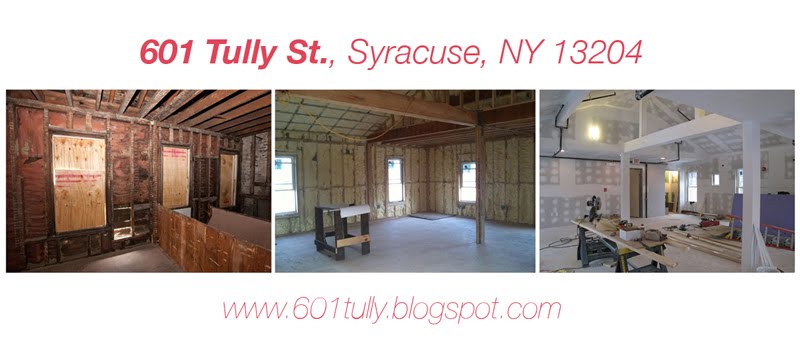About 601 Tully
Check out our new website! 601Tully.syr.edu
601 Tully is a center for engaged practice in Syracuse, NY developed by artist and professor Marion Wilson with a rotating collaborative team of 54 students and neighbors and Anda French of French 2Design. It's a site for meaningful exchange between artists, community members, and scholars in the co-production of culture.
601 Tully includes a contemporary art space, a public events space, a bookstore, a teaching garden, and Recess Cafe West.
In 2009, Wilson purchased the condemned two-story home and local drug hub, and throughout five semesters, Wilson's design/build class re-zoned, designed, renovated and now sustains the physical and programmatic aspects of 601 Tully. The collaborative team has consisted of artists, architects, environmentalists, Fowler High School students, Green Train Workforce, neighbors, and the occasional passerby.
601 Tully is made possible by the generous support of the Syracuse University School of Education, The Kauffman Foundation, The Near West Side Initiative, Imagining America, Home HeadQuarters Inc., Say Yes to Education, and National Grid.
Find us on Facebook!
Wednesday, September 16, 2009
Thoughts on Assignment #1
Narrative
The concept of narrative relates to our interest having the building somehow represent the past, present and future of the Neat Westside. This can be accomplished in a concrete way, through the process of casting physical objects, or in more abstract ways – eg. oral histories, neighborhood questionnaires, or video/photographic projections. 601 Tully has the ability to serve an archival function, to operate as a sort of memory bank for the neighborhood and to also measure change within the neighborhood in real time. The juxtaposition between the relatively permanent elements of the neighborhood – surrounding buildings, Skiddy Park, Blogett Elementary – and the transitory, day-to-day evolution of the Near Westide and 601 Tully can provide a metric for understanding and marking how the neighborhood evolves.
Interaction
Our conversation also established the importance of showing what’s going on inside the building as a means of creating a dialogue between the community-at-large and the goings-on in 601 Tully. This dialogue is seen as a means of integrating the building into its context. Projecting the program of the building outwards into the neighborhood, or inserting the character of the neighborhood itself inside the building is one way to accomplish this. Accordingly, it is important to think about the building not only in terms of aspect – how it is seen as an object and presented to the community, but also prospect – what is seen from the building or how the community is viewed/framed from the building. The threshold between community and building – and interaction from both sides of it – helps make the project about community as a whole, rather than the building as a discrete object. If these values are pushed to their (illogical) extremes, does this mean the disappearance of the building itself?
Some important concepts from everybody’s presentations:
Enric Ruiz Geli – Michael Performative skin, lattice – the idea of individual elements comprising a larger whole. Wrapping surfaces begin to negotiate corners and direct pedestrian traffic.
Daniel Buren - Andrew Collapse of image of the building – continuation of surfaces as a way of integrating into the community
NDSM – Yun Pei Identity is shown thru the interior space. No façade – no building?
Gordon Matta-Clark - Phoebe Reacting against authoritative models – dismantling the center – the most important part – as an institutional critique.
Rachel Whiteread - Mario Representing air, memory by casting negative space. Making concrete (literally and figuratively) the unseen and impermanent.
Tracey Emmon - Sam Collecting memory –personal events turn into a sounding board for a broad audience.
Takashi Horisaki – Jessica Re-presenting the object in a new way to uncover what isn’t seen conventionally.
Tyree Guyton – Kristin Using objects found in one’s local context as a building material to develop a strong sense of place.
Krzysztof Wodiczko - Jamie Building surface as a sounding board. Project out to other buildings to expand the space of 601 Tully.
Agnes Martin – Marion The idea of a trope – the building isn’t what it appears to be.
Teddy Cruz – Zach Using relationships between authority and community as a place of intervention. Understanding local manufacturing processes, spatial practices and projecting from them.

No comments:
Post a Comment